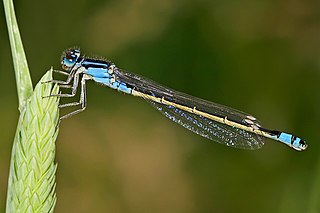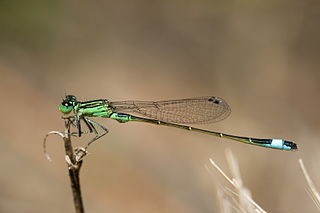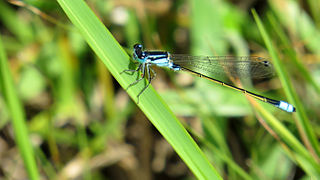
Damselflies are flying insects of the suborder Zygoptera in the order Odonata. They are similar to dragonflies but are smaller and have slimmer bodies. Most species fold the wings along the body when at rest, unlike dragonflies which hold the wings flat and away from the body. Damselflies have existed since the Jurassic, and are found on every continent except Antarctica.

The black-tailed skimmer is a dragonfly belonging to the family Libellulidae.

Enallagma cyathigerum is a species found mainly between latitudes 40°N and 72°N; It is widely distributed in the Palearctic, and the Nearctic species Enallagma annexum was at one time considered to be synonymous with it. The species can reach a length of 32 to 35 mm. It is common in many different countries including Russia, Sweden, Norway, Finland, the United States of America, and South Korea. Damselflies are an important link between the health of the aquatic ecosystem and its response to climate change.

The blue-tailed damselfly or common bluetail is a damselfly, belonging to the family Coenagrionidae.

Ischnura senegalensis, also known variously as common bluetail, marsh bluetail, ubiquitous bluetail, African bluetail, and Senegal golden dartlet, is a widespread damselfly of the family Coenagrionidae. It is native from Africa, through the Middle East, to southern and eastern Asia.

Erythromma najas, the red-eyed damselfly, is a member of the Coenagrionidae family of damselflies.

Ischnura aurora, the gossamer damselfy or golden dartlet and also known as the aurora bluetail, is a species of damselfly in the family Coenagrionidae.

Ischnura is a genus of damselflies known as forktails in the family Coenagrionidae. Forktails are distributed worldwide, including various oceanic islands. The males have a forked projection at the tip of the abdomen which gives the group their common name.

Ischnura genei, the island bluetail damselfly, is a species of damselfly that replaces the blue-tailed damselfly on some Mediterranean islands. It is a small and slender damselfly that tends to be smaller and daintier than the common bluetail. Its main distinguishing features include a black abdomen, which in males carries a striking blue tail-light on S8. Some female colour forms, too, have a blue tail-light on S8, but it tends to be interrupted by a black mark on either end. In some other female colour forms S8 is rusty brown. The male's pterostigma is bi-coloured. In Malta, this species is still frequent and breeds, but it is endangered by habitat loss.

Ischnura heterosticta, one of at least two species with the common name common bluetail, is an Australian damselfly of the family Coenagrionidae. It is the largest of the three Ischnura species in Australia. They are generally found near slow-running or still water. The species is also salt tolerant. It flies from October to March.

Eastern forktail is a member of the damselfly family Coenagrionidae.

Decoy Pit, Pools and Woods is a 17.7-hectare (44-acre) biological Site of Special Scientific Interest south of Aldermaston in Berkshire. An area of 8 hectares is a nature reserve called Decoy Heath, which is managed by the Berkshire, Buckinghamshire and Oxfordshire Wildlife Trust.

Ischnura erratica, the swift forktail, is a species of damselfly in the family Coenagrionidae. It is native to the Pacific Northwest, ranging from British Columbia to northern California.

Ischnura pruinescens is a damselfly in the family Coenagrionidae, commonly known as the colourful bluetail. The taxon has been assessed for the IUCN Red List as being of least concern and is listed in the Catalogue of Life.

Ischnura rubilio, western golden dartlet, is a species of damselfly in the family Coenagrionidae. It is found in Indian subcontinent and Iran.

The Persian damselfly or Dumont's bluetail is a damselfly, belonging to the family Coenagrionidae.
















